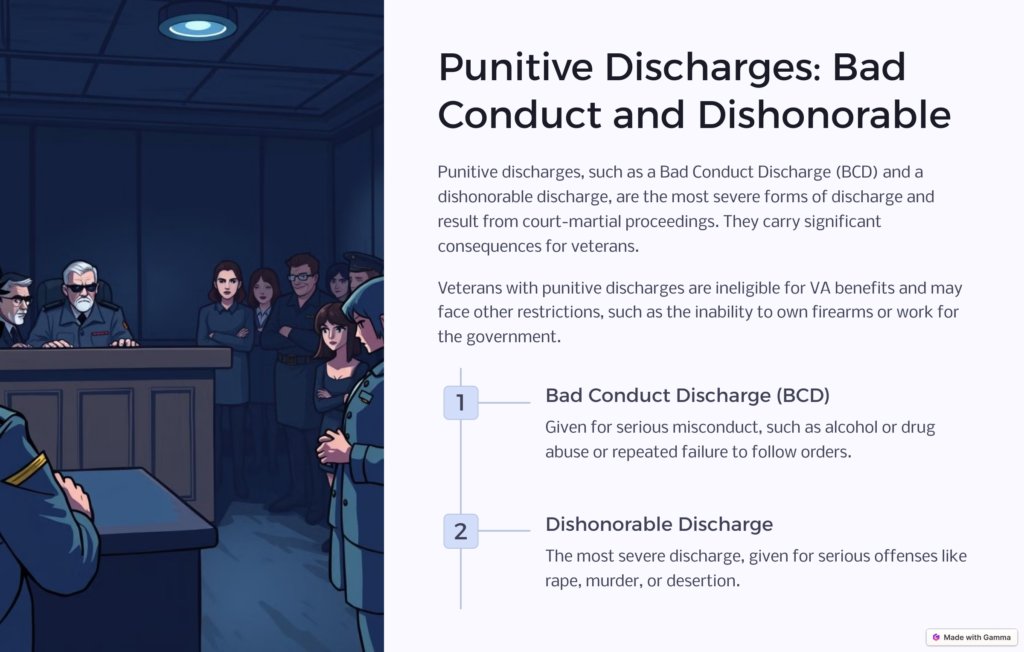Although many believe that there are two types of military discharge—an honorable discharge and a dishonorable discharge—several more statuses can be military discharges.
If you’re expecting any benefit from the United States Department of Veterans Affairs (VA), your discharge status can influence those benefits. It’s important to understand each status and how it might affect you.
The 8 Types of Military Discharge
- Honorable Discharge
- General Discharge
- Entry-Level Separation
- Medical Discharge
- Other Than Honorable Discharge
- Bad Conduct Discharge
- Dishonorable Discharge
- Dismissal (Officer Discharge)
When you exit the military, you receive a military discharge that denotes the circumstances of your military separation in your military record. While an honorable discharge is common, there are other types of military discharge, like general discharge and bad conduct discharge, that could affect your ability to receive VA benefits.
Since your military service discharge goes on your permanent military records, it’s not likely that a veteran can receive a military discharge upgrade. This process requires a discharge review within 15 years from the discharge, and a veteran must show proper evidence of a mishandled discharge to result in changes.
What Is a Military Discharge?
Most active duty service members receive a military discharge before they leave the service. This discharge indicates whether military personnel left the service under favorable or unfavorable conditions, ultimately affecting their eligibility for veterans’ benefits and reenlistment. The discharge also proves that the service member is no longer required to perform services in the armed forces.

There are two types of military discharge by which each distinction is characterized: administrative and punitive. An administrative discharge is one in which the military separates you from service through administrative actions. This can be an involuntary separation due to decisions from the medical evaluation board or improper conduct—or, voluntary reasons, such as deciding to leave the service after completing the current term. Administrative separation can lead to an honorable, general, or Other Than Honorable discharge.
A punitive discharge is one that commonly results in a dishonorable discharge. Punitive separation requires the court to step in for reasons such as substance abuse, misconduct, security breaches, or failure to perform military service duties. This unfavorable discharge can affect a service member’s ability to complete future military service and receive veteran benefits, like VA disability benefits, from the Department of Veterans Affairs.
In order to be eligible for VA benefits and VA health care, the service member’s discharge status must not be classified as dishonorable. However, in certain conditions, service members with undesirable or bad conduct may still be eligible for some benefits based on a determination by the VA.
How Are These 8 Discharges Different?
In most circumstances, service members will receive a discharge under either dishonorable or honorable conditions upon leaving the armed forces. The following sections explore types of military discharge that fall within administrative and punitive discharges.
1. Honorable Discharge

An honorable discharge is the most common type of military discharge. This discharge shows that a military member did not leave the service under dishonorable conditions, like bad conduct or committing a crime. An honorable discharge allows a military member to receive VA benefits, such as a pension, VA home loan, and health insurance.
To receive an honorable discharge, a service member must have completed their service or have a legitimate reason for not doing so and followed the armed forces’ rules and expectations. This administrative discharge does not require the military member to go through the court system.
Service members who get honorably discharged from the military may also have a reason for medical retirement if they are unable to complete their duties. Such is the case with post-traumatic stress disorder (PTSD) symptoms, pregnancy, or a disability occurring while on duty.
2. General Discharge
A general discharge is another form of military administrative discharge, but it is not counted the same as honorable. However, a general discharge isn’t a dishonorable discharge.
Military members who receive a general discharge often do so because their branch of service considers them to have served honorably. They may have some marks on their record that prevent them from receiving an honorable discharge, but it’s not considered a “bad discharge.”
Veterans with this service determination do not have misconduct issues that would not require a judicial punishment, as with a dishonorable discharge. Still, a service member’s DD Form 214 may denote why a general discharge was given, and the reasons can be very specific. When this happens, a person may be unable to reenlist in the military, depending on the reasons for discharge. In addition, veterans with a general discharge may not receive GI Bill benefits, which require an honorable discharge.
3. Entry-Level Separation
An entry-level separation (ELS) is not technically considered an honorable or dishonorable discharge but is a form of administrative discharge. This discharge characterization is given to military members who must leave the service within the first 180 days of joining.
This often happens because of a medical issue or failure to meet the demands of the military, such as being unable to keep up with basic training.
For an entry-level separation to occur, an individual’s command must take proper steps before serving the separation. For instance, opportunities like one-on-one meetings with the individual or written notices can prove that the individual’s command attempted to solve a problem before taking other measures.
In many cases, these opportunities may be enough to get the service member back on track. If not, their command can initiate a discharge through the ELS process.
4. Medical Discharge

Medical discharges can happen for various reasons related to an injury, condition, or disability. In some cases, a medical discharge stems from a condition made worse through military service. In other cases, the injury, illness, or disability may have occurred during military service, preventing the military member from serving properly.
A medical discharge is a military administrative discharge that typically is not viewed negatively on an individual’s record, depending on the condition’s circumstances. To receive this type of military discharge, a service member must undergo a medical evaluation that proves they are no longer fit to continue their duties.
Military members with a medical discharge can often apply for disability benefits through the veterans’ benefit system. This program requires a service connection before paying out benefits, and veterans can usually prove the service connection with evidence from medical evaluations used to trigger the discharge process.
5. Other Than Honorable Discharge
An Other Than Honorable (OTH) discharge is an administrative discharge that is not viewed as favorably as an honorable or general discharge. This characterization is usually reserved for military members who have not withheld the integrity expectations of an armed services member. Some situations that could lead to these administrative discharges include being found guilty of adultery while in the service or receiving a conviction in civilian court.
The military often gives this discharge to service members who break the rules or exhibit negative behaviors but whose actions don’t warrant judicial intervention. Because of the circumstances surrounding it, it’s rare for veterans with an OTH discharge to be eligible to receive VA benefits.

6. Bad Conduct Discharge
A Bad Conduct Discharge (BCD) is one of the forms of a punitive discharge, meaning that it must go through the military justice system to happen. This type of discharge is for a military member who exhibits bad conduct in some way, but it’s a less severe punishment than a dishonorable discharge.
Some potential reasons for a BCD include alcohol or drug abuse or repeatedly failing to follow orders. Often, people who receive a BCD are imprisoned beforehand, either through the military or as a civilian. The discharge leaves a negative mark on a person’s record and will prevent them from getting veteran benefits. A DD214 will also likely note the reason(s) for the discharge.
7. Dishonorable Discharge
A dishonorable discharge is the type of military discharge that carries the most consequences. This discharge typically comes from behaviors or actions that go entirely against military rules, such as rape, murder, or missing from military service. The punitive discharge stems from a court-martial process and remains on a service member’s permanent record like other types of military discharge.
With this discharge, not only will a service member not receive VA benefits, but they also are unable to have firearms or ammunition. The discharge can show up on federal background checks, making it challenging for a veteran to find employment.
Veterans with this determination may also not be able to vote, work for the government, get a loan, or receive government assistance.
8. Dismissal (Officer Discharge)
Commissioned officers who need to be discharged from the military undergo a different process than non-officers. Although they still may receive a negative discharge, they do not receive a BCD or a dishonorable discharge for wrongdoings. Instead, they may receive what’s known as a dismissal or officer discharge that relieves them from their service.
Although the names aren’t the same, an officer discharge carries the same weight as a BCD or dishonorable discharge in terms of the officer’s record and their ability to claim veterans benefits later. With an officer, discharge can come with a lowered rank set to the last rank the officer completed without issue and the inability to receive benefits. This happens if the officer has been court-martialed.
What Is Willful Misconduct?
Willful misconduct, by definition, is the purposeful act of doing something wrong or improperly. In the military, someone may perform willful misconduct if they intentionally go against military rules and regulations, like driving a vehicle while intoxicated. This is a purposeful act that the person knows could cause harm to themselves, yet commits the act anyway.
If the VA determines that your actions leading to an injury, disability, or death are subject to willful misconduct, it can refuse to pay you disability compensation.
Similarly, the veteran’s family may not qualify for VA benefits if the veteran’s actions fall under willful misconduct. Tobacco use, alcohol or drug abuse, and suicide can potentially fall under willful misconduct definitions.
Honorable vs Dishonorable Discharge
Your military discharge papers remain on your military records permanently and may affect your ability to find civilian employment and receive VA or government assistance. In most cases, veterans with punitive discharges are ineligible for any VA benefits, and some benefits are not made available to veterans with discharges other than honorable. Your discharge can also affect your ability to reenlist.
The military offers an appeals process for military members who feel they need a discharge upgrade because their initial discharge is inaccurate or unfair. However, these appeal requests frequently get denied. In this case, it may be helpful to retain the services of a discharge upgrade lawyer.
If a veteran does make it to an Army Discharge Review Board (or Coast Guard, Air Force, etc.), they must show plenty of evidence to the administrative discharge board to turn over a decision, especially in the case of a punitive discharge. A VA disability lawyer and other professionals who help veterans won’t be able to assist someone ineligible for VA benefits according to their discharge papers.
 Benefits.com Advisors
Benefits.com Advisors
With expertise spanning local, state, and federal benefit programs, our team is dedicated to guiding individuals towards the perfect program tailored to their unique circumstances.
Rise to the top with Peak Benefits!
Join our Peak Benefits Newsletter for the latest news, resources, and offers on all things government benefits.





















